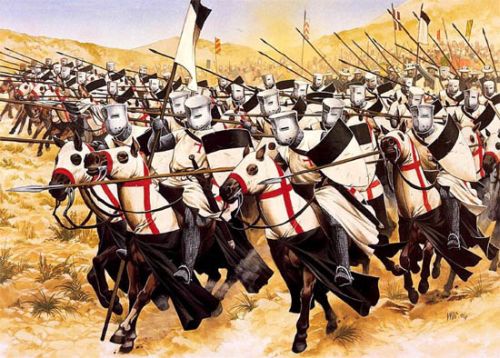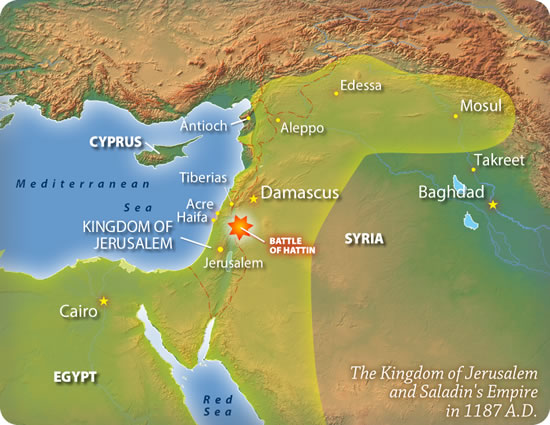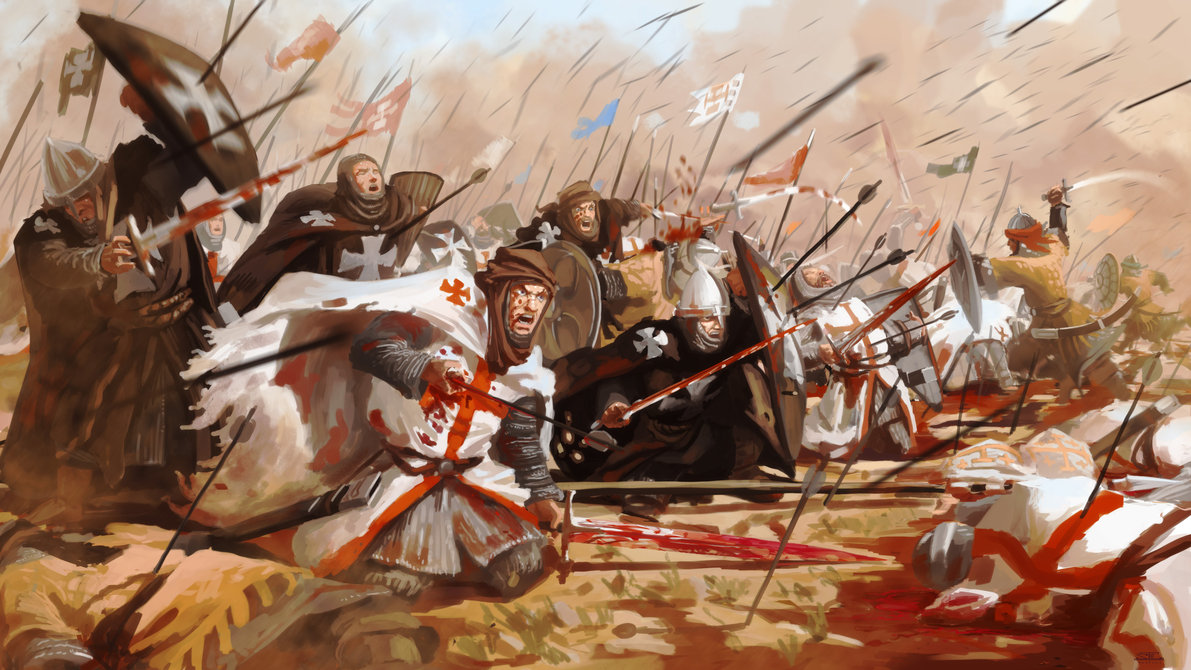The Battle of Hattin
During the 1170s, Saladin began expanding his power from Egypt and worked to unite the Muslim states surrounding the Holy Land. This resulted in the Kingdom of Jerusalem being encircled by a unified enemy for the first time in its history. Attacking the Crusader state in 1177, Saladin was defeated by Baldwin IV at the Battle of Montgisard. In the wake of the battle, an uneasy truce existed between the two sides. As the Muslim states were uniting, there was increasing dissention in Jerusalem with the elevation of Guy of Lusignan to the throne in 1186.
Claiming the throne through his marriage to Sibylla, mother of the late child-king Baldwin V, Guy’s ascension was supported by Raynald of Chatillon and the military orders such as the Knights Templar. Others, such as Raymond III of Tripoli, who had been Baldwin V’s regent, were angered by the move. Tensions quickly escalated between the two parties and civil war was only avoided through mediation by Balian of Ibelin. Despite this, Guy’s situation remained tenuous as Raynald repeatedly violated the truce with Saladin by attacking Muslim trade caravans.
This came to a head when his men assaulted a large caravan travelling north from Cairo. In the fighting, his troops killed many of the guards, captured the merchants, and stole the goods. Operating within in the terms of the truce, Saladin sent envoys to Guy seeking compensation and redress. Reliant on Raynald to maintain his power, Guy, who conceded that they were in the right, was forced to send them away unsatisfied, despite knowing that it would mean war. To the north, Raymond elected to conclude a separate peace with Saladin to protect his lands.
Saladin on the Move:
This deal backfired when Saladin requested permission for his son, Al-Afdal, to lead a force through Raymond’s lands. Compelled to allow this, Raymond saw 7,000 men enter Galilee and defeat a Crusader force at Cresson on May 1. Calling his allies to assemble, Guy hoped to strike before Saladin could invade in force. Renouncing his treaty with Saladin, Raymond fully reconciled with Guy and a Crusader army of around 20,000 men formed near Acre. Advancing, they occupied a strong position near the springs at Sephoria.
Possessing a force nearly the size of Saladin’s, the Crusaders had defeated earlier invasions by holding strong positions with reliable water sources while allowing the heat to cripple the enemy. Aware of past failings, Saladin sought to lure Guy’s army away from Sephoria so that it could be defeated in open battle. To accomplish this, he personally led an attack against Raymond’s fortress at Tiberias on July 2 while his main army remained at Kafr Sabt. That night, the Crusader leaders held a war council to determine their course of action.
While the majority was for pressing on to Tiberias, Raymond argued for remaining in the position at Sephoria, even if it meant losing his fortress. Though the precise details of this meeting are not known, Guy elected to push on in the morning. Marching out on July 3, the vanguard was led by Raymond, the main army by Guy, and the rearguard by Balian, Raynald, and the military orders. Moving slowly and under constant harassment by Saladin’s cavalry, they reached the springs at Turan (six miles away) around noon. Concentrating around the spring, the Crusaders eagerly took water.
The Battle of Hattin:
Though Tiberias was still nine miles away, with no reliable water en route, Guy insisted on pressing on that afternoon. Under increasing attacks from Saladin’s men, the Crusaders reached a plain by the twin hills of the Horns of Hattin by mid-afternoon. Advancing with his main body, Saladin began attacking in force and ordered the wings of his army to sweep around the Crusaders. Attacking, they surrounded Guy’s thirsty men and cut off their line of retreat back to the springs at Turan. Under increasing pressure, the Crusader rearguard was forced to halt and give battle, stopping the entire army’s advance.
Though advised to fight on to reach Tiberias and water, Guy elected to halt the advance for the night. Surrounded by the enemy, the Crusader camp possessed a well but it was dry. The next morning, Guy’s army awoke to blinding smoke. This came from fires set by Saladin’s men to screen their actions and increase the Crusaders’ misery. With his men weakened and thirsty, Guy broke camp and ordered an advance towards the springs of Hattin. Despite having sufficient numbers to break through the Muslim lines, fatigue and thirst badly weakened the cohesion of the Crusader army.
Advancing, the Crusaders were effectively counterattacked by Saladin. Two charges by Raymond saw him break through the enemy lines, but once outside the Muslim perimeter, he lacked enough men to influence the battle. As a result, he retreated from the field. Desperate for water, much of Guy’s infantry attempted a similar breakout, but failed. Forced onto the Horns of Hattin, the majority of this force was destroyed. Without infantry support, Guy’s trapped knights were unhorsed by Muslim archers and forced to fight on foot. Though fighting with determination, they were driven onto the Horns. After three charges against the Muslim lines failed, the survivors were forced to surrender.
Aftermath of the Battle of Hattin
Precise casualties for the battle are not known, but it resulted in the destruction of the majority of the Crusader army. Among those captured were Guy and Raynald. While the former was treated well, the latter was personally executed by Saladin for his past transgressions. Also lost in the fighting was a relic of the True Cross which was sent to Damascus. Quickly advancing in the wake of his victory, Saladin captured Acre, Nablus, Jaffa, Toron, Sidon, Beirut, and Ascalon in rapid succession. Moving against Jerusalem that September, it was surrendered by Balian on October 2. The defeat at Hattin and subsequent loss of Jerusalem led to the Third Crusade. Beginning in 1189, it saw troops under Richard the Lionheart, Frederick I Barbarossa, and Philip Augustus advance on the Holy Land.



